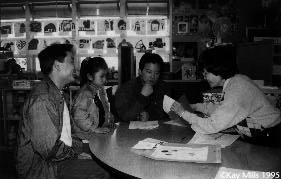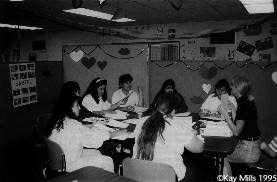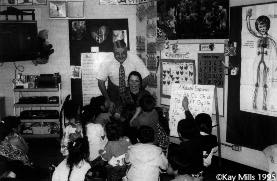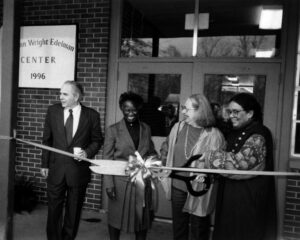SAN JOSE–Tin Hout sits in one of the pint-sized chairs in which parents inevitably find themselves when they confer with their child’s kindergarten teacher. His five-year-old daughter Marina stands shyly, but attentively, beside him as Santee School teacher Margie Oyama reports that the child is progressing well. Marina, who attended Head Start last year, can count almost to 30, knows her colors, recognizes shapes.

There is one more person in what would otherwise be a typical parent-conference picture. Nisseth Sath, a refugee from Cambodia like many of the families he helps, is translating Oyama’s report into the Khmer language that Marina’s father speaks. Sath telephones many of the parents to schedule these conferences, helps families negotiate government bureaucracies, and sometimes transports people to doctors’ appointments. His job is called “family advocate,” a key part of a nationwide pilot project to ease children’s transition from the federal Head Start pre-school program into the early elementary grades.Across the country, 32 of these transition projects are in their fourth year as Head Start and selected public schools examine how they can keep children interested in learning and parents involved in that process despite what is typically deep poverty. The projects are accompanied by a massive study posing two questions: What really affects children’s successful development in the early years of schooling, and will these transition efforts help? Will prolonging the intensive attention families normally receive for one or two years when their children are in Head Start cement the gains the children have made?

Congress established these projects in 1990. Politicians clearly had in mind a 1969 study, called flawed and limited by many in both the Head Start and research communities, that showed the gains Head Start children made disappeared by second or third grade. Whether this fade-out effect is valid, and whether public schools rather than Head Start should be addressing it, Head Start is taking the initiative. The transition project clearly is a school-reform effort, aimed at encouraging elementary schools to be more responsive to children’s own pace of development and to make parents feel more welcome in the schools.

The San Jose project, administered by the Santa Clara County Office of Education, focuses on Santee and McKinley Schools and their three feeder Head Start programs in the east central area of the city. The schools operate year-round, and the first group of Head Start alumni moved into kindergarten during the summer of 1992. By now, 360 students are involved in kindergarten, first and second grades. Not all of them attended Head Start. The law specifies that all children in a transition-project classroom with former Head Start students receive the same services. Head Start itself enrolls only 20 to 25 per cent of area children who are eligible.
Over the life of the San Jose project, its director Don Bolce estimates that $1.5 million has been spent on screening the children for medical and dental problems, giving teachers curriculum training, providing classroom supplies, offering English language and parenting classes for adults, enabling the schools to have full-time nurses, and paying the family advocates, who are the soul of the project. That works out to about $1,400 per family per year for these extra services–not a lavish amount but a big boost for struggling schools.
Anecdotal evidence from the San Jose project indicates that it has helped many Cambodian, Vietnamese and Latino immigrant families become better adjusted to American life and help their children know what to expect in school. Education officials are optimistic these children are more likely to stay in school. This, despite the fact that the children move frequently; their parents are unemployed or poorly paid because they speak little or no English. Some were not literate even in their native languages. Many of the adults fled war and refugee camps in Southeast Asia or economic hardships in Mexico.
The best-intentioned plans face strains going from policy papers to the messy world of reality. Federal money, supplies that teachers ordered, and even a trailer intended as a transition-project office and parent center didn’t arrive on schedule. The small district has had three superintendents during the project. One school changed principals. Teachers had different levels of enthusiasm for the project. The county tried to move the family advocates from the community into the central Head Start office. Some children planning to go to one of the participating schools found they couldn’t because it was overcrowded. The director was not always accessible because he was deeply involved with national and state Head Start programs and school reform efforts.
“This is a program of great promise, that has far more right than wrong with it,” says Ken Van Otten, who is principal at McKinley. “It is richly human as opposed to something written down in a proposal or guidelines.” Van Otten thinks the project’s services should continue through fifth grade rather than stopping with second graders.
Spending several mornings in the parents’ center next to either school–they are about a mile apart in an area of stucco strip malls and small apartment buildings in various states of repair–demonstrates what Van Otten means about the human side of the project. One day Gretchen Biswell is teaching English to seven women; another morning women are creating colorful Mexican craftwork; yet another day, mothers share a Valentines pot luck with homemade tortillas and a Cambodian noodle dish. The family advocates work in the same trailers, ready if someone needs to copy a document or translate an undecipherable government form–or is just seeking a sympathetic ear.
Biswell shows a picture from a magazine to Teresa Alvarez, who uses her growing English vocabulary to describe the scene. Alvarez, who came to the United States permanently in 1988 from Irapuato, an industrial city in Mexico, had worked as a secretary at home. When she first came to the United States, she said, she was “muy triste.” She felt she was doing nothing. When the transition program started, she met Santee kindergarten teacher Diana Gallegos, who asked her to help in her classroom.
Alvarez also took parenting classes, which helped her learn patience with her family. Her self-esteem returned. Now she is studying English. But she and other parents are perturbed that the project is winding down; they voice the disappointment of generations of others who have participated in social experiments that inevitably end. “I know how to deal with the school now. I know about its responsibility. What about the parents who follow us? How will they know?”
Unlike Alvarez, Pok Mao, who came to the United States in 1984 after enduring the Khmer Rouge regime and war in Cambodia, had had no schooling in the rural area where her father was a rice farmer. She and her husband, who is handicapped and cannot work, have five children, two of whom have been in the transition project. Pok Mao liked the project’s English class, adding quietly but proudly that she is now in a more advanced course. “If I know more English, I like to be a nurse,” she says.”Before the project started, I thought the goal should be engaging parents in their children’s education,” said Margo Maida, the family advocates’ supervisor. “Once we started, I realized our immediate goal was to stabilize families. It was impossible to get them involved in children’s educations when they were worried about getting food on the table.” Once they trust you, she said, you can talk about how they raise their children.
For those children, the transition’s project’s most visible change is one they shouldn’t notice. Their Head Start and elementary teachers use the same curriculum and therefore their classrooms are arranged the same way. Educators call the process, developed by the High/Scope Educational Research Foundation in Ypsilanti, Mich., “developmentally appropriate curriculum.”
That means children are encouraged to choose at least some of their learning activities during the day and to move at their own pace, always with guidance but without teachers constantly lecturing and children passively listening. One administrator calls it “management by walking around.”

It’s hard work setting up the rooms, planning what will work where, labeling everything from building blocks to light switches. Jan White, who taught kindergarten the project’s first year at McKinley, says she and fellow teacher Concha Garcia reorganized their room three times before they settled on an arrangement that worked well for them. At first it was also hard to trust children’s natural curiosity as they made some of their own decisions about learning, White said, adding that support from the transition staff, trainers and school administrators helped teachers make the leap.
These Head Start children go into kindergarten classrooms that look familiar, so they know what to do, even on a visit to the elementary school before classes begin, said Head Start teacher Candy Helms. Last spring, for example, she took her class on the short walk down the street from the Monte Alban Head Start center to Santee School. Parents went along on that visit. Kindergarten teachers also visited the Head Start class–one read the children a story–and talked with them about what to expect.
As a result, said Margie Oyama, the children are able to take more responsibility when they get to kindergarten. “If they haven’t been to pre-school, they tend to cry a lot. Of course, a few cry a lot anyway. With this program, they know how to learn, how to listen, how to interact with other children.”

Some of this communication between principals, teachers and staff so evident early on may be bogging down as the project nears its end. The family advocates are worried about finding new jobs. Some parents complain they are not as involved in decisions as they once were. More families and more teachers are part of the project, so less attention can be given any one family or class. For example, Jan White, who now teaches second grade, thinks the program isn’t as effective for her students. “The program went gangbusters the first year,” says White. “I was into it. Like any new project. That lasted for a year and a half. By first grade the effort was watered down a bit. This year it’s been a total bomb…I don’t see Don. I never see Margo. I’m not complaining but it’s clear it’s not a priority any more.”
The county’s own assessment of the project suggested that the project director should be more accessible to staff and visible at the schools. Bolce, who has traveled extensively to help shore up Head Start’s tenuous position with members of Congress and to advance the need for continuity in early childhood education, acknowledges the criticism. “There are really so many different levels at which you operate. For example, he said,” We weren’t sure whether we’d even be here this year. So some of that national activity played a part in keeping the program alive. You pay a price one year but it pays off the next.”
The local assessment will be the only one completed for the San Jose project. The other 31 pilot projects, which take in third grade as well, will be evaluated by affiliated universities and the Civitan International Research Center at the University of Alabama in Birmingham. The San Jose project was not able to set up transition and control groups at random as national criteria dictate, explained Craig Ramey, Civitan’s director. So it couldn’t be included. “If you see differences, do you know whether they were there already?” he said. “But that doesn’t mean it’s not a good program.”
Evaluators from the county education office have regularly done extensive interviews with children, parents and educators. So far, they have concluded that the transition students had fewer non-excused absences than those not in the program, became more confident during the school year, and had received free health and dental care as planned, while their parents increased their involvement in the classroom and with children’s homework.
But “if you say, I don’t have numbers, that’s right, I don’t have numbers,” says researcher Gretchen Wehrle. Researchers found that children’s and parents’ limited English skills restricted what they could test with any confidence. But “measuring change is not just about test scores, especially given this population,” Wehrle said. “Now, if a parent goes to a doctor or nurse, they know what questions to ask. How do you measure that?”
It’s too bad, however, that the San Jose project isn’t part of the overall study, says Van Otten. “Our results won’t carry as much weight nationally.”
Nonetheless, the principal sees a lasting legacy. Children are in school longer and liking it more. They are healthier because of the medical screenings. “We have come to see how much parents can do–how much difference they make–in reality. They also tend to stay in the community, largely because they have a tie to the school and they can see the difference a school can make.”
Mary Garcia, new this past school year as Santee’s principal, says that “given the condition of public schools not just in California but across the country, it’s obviously a big plus” to have received the additional manpower, material and training brought by the transition project. On the downside, she thinks the program should have concentrated more on academics, on giving the children language skills. “I would rather see the money and resources concentrated on three or four Head Start pre-school programs.” With 700 students at Santee, the number who have had Head Start is “not even a drop in the bucket. That is a big need.”
Looking at the reform efforts, project director Bolce is at once frustrated and optimistic. “I don’t feel we’ve made institutional change. On the other hand,” he asks,”what institutional change can you expect” in just a few years? At the same time, it’s clear to Bolce that the project has had “an impact on a relatively sizeable number of parents. In both schools,there is a core of people who’ve experienced change and will continue to be a force at schools for themselves and their families.”Transition activities between all Head Start programs and elementary school are now required under a federal law passed last year. But few predict that Congress will finance the current level of transition services, which may total more than $100 million for the national pilot project, including the accompanying research, when the effort finally concludes after six years’ work. “Nor should it have to,” said Michele Plutro, the Head Start specialist coordinating these projects, “because good early childhood education ought to include these services.” If the project shows people that these efforts work, the hope is that local communities will put up their own money for transition.
The San Jose team hopes to use what it has learned about how schools are organized and how parents can be involved as transition activities are developed in five other local school districts this year. The task now—convincing principals and teachers, sometimes at odds over union rules and pay disputes, to buy into more work with less outside money and probably fewer, if any, family advocates–and still make future transition projects work.
©1995 Kay Mills
Kay Mills is a freelance writer in Santa Monica who is researching the Head Start program across America.



